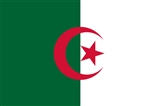
region of Northwest Africa with Algiers
as its capital.
In terms of land area, it is the largest country in Africa
and the Arab World
(now that Sudan has been split up), and also of the countries bordering the Mediterranean Sea
; it is also the tenth-largest country in the world.
1631 The sack of Baltimore: the Irish village of Baltimore is attacked by Algerian pirates.
1830 French invasion of Algeria
1830 France invades Algeria.
1867 Maronite nationalist leader Youssef Karam leaves Lebanon on board a French ship for Algeria
1945 Hundreds of Algerian civilians are killed by French Army soldiers in the Sétif massacre.
1955 In Morocco, a force of Berbers from the Atlas Mountains region of Algeria raid two rural settlements and kill 77 French nationals.
1961 In France a referendum supports Charles de Gaulle's policies in Algeria.
1961 Scores of Algerian protesters (some claim up to 400) are massacred by the Paris police at the instigation of Nazi collaborator Maurice Papon, then chief of the Prefecture of Police.
1962 French President Charles De Gaulle calls for Algeria to be granted independence.
1962 Algeria becomes independent from France.

